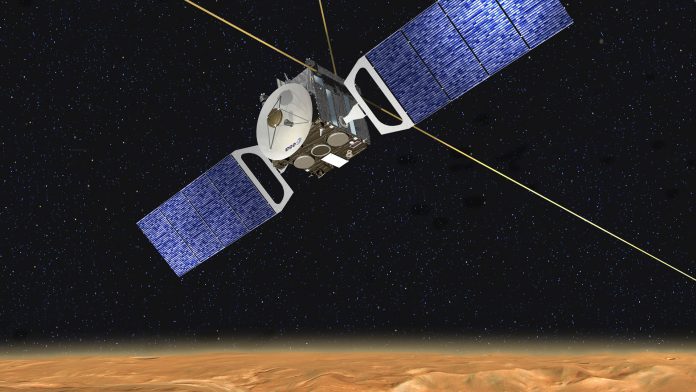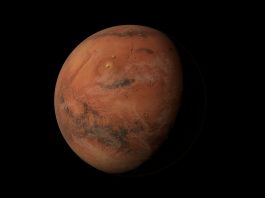Dr Dmitrij Titov, the European Space Agency’s Project Scientist for Mars Express, discusses both the history and future potential of this exciting mission to the Red Planet.
After almost 17 years in orbit, Mars Express remains one of ESA’s most scientifically productive Solar System missions. Mars Express was designed as a survey mission to study almost all fundamental aspects related to the geology and evolution, climatology, aeronomy, and habitability of the Red Planet.
Geology, interiors and history
Almost complete surface imaging at about 12m/pixel resolution combined with the spectral mapping of surface minerals revealed the planet’s geological history, putting in chronological order the sequence of events and processes that shaped the planet over 4.5 billion years. Subsurface radar sounding added the third dimension to the study, showing buried geological structures and relations between them, ‘slicing’ the polar caps and searching for liquid water. Ubiquitous evidences of liquid water, that had flown on and flooded the surface of Mars in the ancient past, posed a question of how did the planet evolve to its present extremely arid state? To answer this question, Mars Express measured oxygen and hydrogen ions escaping from the upper atmosphere over one-and-half solar cycles. This led to the conclusion that only about 10 mbar of gas, that is equivalent to the current Martian atmosphere, had been blown with the solar wind over the planet’s life. This small amount suggests other, more effective escape channels to be at work.
Following the discovery of liquid water under the south polar layered deposits, the subsurface radar MARSIS continued observations of a much larger area of 600 x 600km and found other sites with strong reflections indicating wet layers. High-resolution stereo colour camera HRSC imaged ~81.7% of the surface at <20m/pixel resolution. Single-orbit Digital Elevation Models (DEM) now cover ~45%. Two multi-orbit DEMs were released covering a 30° latitude x 45° longitude area including the ExoMars landing site and, for the first time, the complete Southern polar cap with better than twice the Mars Orbiter Laser Altimeter (MOLA) resolution (50m/pixel). Geological analysis of the images indicated evidence of a planet-wide groundwater system on Mars, debris-covered stagnant ice deposits within the southern highlands of Mars and contributed to the study of fluvial deposit systems. Maps of global mineral distribution and a catalogue of chemical alteration features with resolution of 200m/pixel and mineral abundances were released by imaging spectrometer OMEGA.
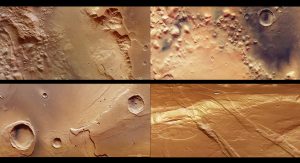
© ESA/DLR/FU Berlin
Meteorology and climatology
Planetary atmospheres are complex dynamic systems for which long term series of measurements are of key importance. For more than one and a half decades, Mars Express has been continuously monitoring the main parameters of the atmosphere and ionosphere, such as the temperature, abundance and cycles of minor constituents; dust and ice content; and electron density, to unveil physical processes hidden behind the observed variabilities and complex interactions between atmospheric layers.
Following earlier findings, the mission explained the annual cycle of atmospheric water by its intensive sublimation from the polar caps with subsequent transport all over the planet by winds. Water vapour abundance was found to be anticorrelated with ozone, suggesting chemical coupling between these minor species. Mars Express found that the ionosphere – the tiny veil of rarified ionised gas above 100km – is strongly affected not only by UV illumination from the Sun and solar wind, but also by a weak crustal magnetic field and dust in the lower atmosphere.
Despite its mature age, the ‘teenage’ Mars Express is still in good health and mood. Recent discoveries of liquid water underneath the 1.5km-thick polar cap and abundance spikes of methane, the gas usually associated with microbial activity, have proven that the mission is still capable of making scientific breakthroughs.
Indeed, a recent highlight was the simultaneous observation of a methane abundance ‘spike’ in the Gale crater by ‘the high resolution spectrometer PFS onboard Mars Express and Curiosity rover. However, another methane enhancement observed by Curiosity on June 19, 2019 was not confirmed either by Mars Express or the Trace Gas Orbiter (TGO) that poses serious challenges to both observations and models. A new method of joint analysis of spectrometers SPICAM and PFS data improved constraints on the H2O vertical distribution.
The structure of daytime convection boundary layer and its dependence on the surface topography were derived from the Mars radio-occultation dataset. Mars Express collected and preliminarily analysed a large amount of data during the global dust storm in the summer of 2018. HRSC and Visual Monitoring Cameras (VMCs) monitored the evolution of several local dust storms over the northern hemisphere. MEX and the Trace Gas Orbiter (TGO) began implementing the joint observation programme to cross-calibrate the instruments and exploit new opportunities provided by the tandem of ESA spacecraft at Mars.
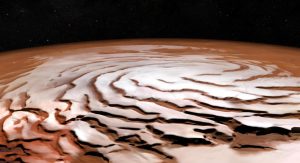
© ESA/DLR/FU Berlin
Thermosphere and ionosphere
Mars Express passes the second solar minimum since the time it arrived at the planet. Analysis of the bow shock crossings showed that its distance to the planet increases on average by 7% (~0.17 RM) between the solar minimum and maximum. Investigations of detailed structures showed that high solar wind dynamic pressure compresses the ionosphere on a global scale. The strong and patchy crustal magnetic field alters the solar wind interaction and prevents the ionopause from forming. The altitude of the ionospheric peak rises as the lower atmosphere expands responding to increased dust load during dust storms.
Phobos and Deimos
A unique feature of the Mars Express orbit is its regular encounters with the Martian moon, Phobos. In 2019, Mars Express performed 12 flybys of Phobos with a distance of <1,000km, augmenting the spatial and spectral coverage to constrain the age of Stickney crater and surface properties. In total, 75 observations of celestial bodies (Phobos, Deimos, other planets, the Pleiades) have helped to constantly improve the ephemerides of the Martian moons.
Mars Express approaches as close as 50km to the Phobos, taking images with up to few metres resolution and investigating it with all instruments. This prepares the scene for a future sampling of Phobos by JAXA’s Martian Moons eXploration (MMX) mission.
The spacecraft is not alone at Mars and works in tight collaboration with other members of the ‘space family’, especially NASA’s Mars Reconnaissance Orbiter (MRO), the MAVEN mission, the Curiosity rover, and the ESA-Roscosmos Trace Gas Orbiter.
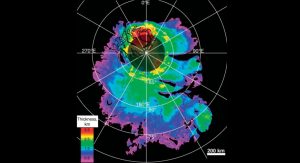
Still learning
Mars Express is still learning to fly. A significant recent engineering achievement was the flawless transition to the ‘gyroless’ attitude control and operations mode on the spacecraft, that would allow mitigating the onboard gyros ageing and extending the mission lifetime.
The mission even acquired a new payload: the engineering Visual Monitoring Camera (VMC) has been successfully converted into a science instrument and included in the science programme and operations.
The mission extension till the end of 2020 has been approved. A decision by the Science Programme Committee on further extension of the mission is expected in autumn 2020.
The science potential and particularity of this extension interval is determined by the combination of favourable observation conditions and novel mission capabilities. The illumination and data downlink conditions will be very good for pericentre imaging of all latitudes. The coming years would provide excellent opportunities for observations of annual cycles of water, clouds, and dust and their influence on the entire atmosphere. Furthermore, it will feature the approach to the solar maximum #25, enabling a unique opportunity to compare it with cycle #24.
The simultaneous presence of Mars Express and TGO orbiters and the long-awaited ExoMars lander and rover will provide, for the first time, a unique opportunity for European scientists to perform a broad palette of synergistic remote sensing and in-situ investigations of the planet and its immediate environment. Mars Express will continue collaboration with NASA’s MAVEN and Mars-2020 rover and establish co-operation with the HX-1 mission of China.
Six ‘seasons’ of Phobos encounters with about 30 flybys will be available in this extension thus making a strong case for scientific collaboration with JAXA’s MMX mission.
In the coming years, Mars Express scientific programme includes both augmenting the coverage and extending long-time series as well as new elements and potential discoveries. In general, the observation strategy will migrate from global survey to the investigation of selected targets and observation campaigns. The planned science activities are as follows.
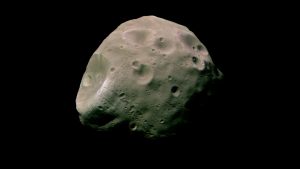
© ESA/DLR/FU Berlin, CC BY-SA IGO 3.0
Geology and history
Two novelties are essential in the extension period. HRSC will almost complete the surface imaging with coverage reaching ~95%. Due to atmospheric constraints and coverage gaps, not all earlier images are usable for generation of the most accurate multi-orbit DEM products. Thus, closing the gaps will significantly enhance the value of the already existing imaging data and will allow production of multi-orbit 50m/pixel DEMs as well as corresponding mosaics with up to 12.5m/pixel resolution. This would represent a major improvement in resolution of the global topography relative to NASA’s MOLA/MGS and allow the creation of global view of Mars.
Mars Express will support rover missions by continuously improving local and regional context topography (DEM), multispectral mapping, and geology, in particular focusing on collaboration with ExoMars in characterisation of Oxia Planum. The subsurface radar MARSIS will augment high-resolution sounding, in particular of the polar layered deposits. OMEGA will continue spectral imaging of surface targets. The Mars Express team will exploit the combination of geomorphological, chronological and mineralogical data to continue unveiling the planet and climate history.
Meteorology and climatology
Mars Express will implement several new approaches:
- Collaboration with TGO in the study of the atmospheric composition and chemistry and, in particular, Mars Express-TGO radio-occultation will be used to study couplings between the lower and middle atmosphere and influence of dust on the atmosphere;
- The mission will perform campaigns of global snapshots of meteorological parameters from afar with a cadence of around one hour to determine instantaneous global states of the atmosphere and its evolution. Such strategy, reminiscent of what geostationary satellites do on Earth, has been proven useful by MAVEN; and
- A new ‘scan pointing mode will be used to study daily variations of suspended aerosols and mesoscale atmospheric circulation over specific regions of interest (e.g., Tharsis, Hellas basin).
Mars Express will expand its programme of global atmospheric monitoring by regional observations in co-ordination and support of the surface missions. Since duration of time series is essential for climatology, the mission will continue monitoring the meteorological parameters, minor species, clouds, and dust studying annual and diurnal changes, and filling coverage gaps. Study of the inter-annual variability of the climate using synergy of data from different instruments supported by modelling will be one of the main objectives. Unique to MEX will be atmospheric temperature monitoring and methane search by PFS as well as co-ordinated PFS-SPICAM observations constraining the H2O vertical distribution.
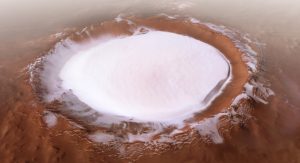
© ESA/DLR/FU Berlin
Thermosphere and ionosphere
This science area will benefit from using cross-link Mars Express-TGO radio-occultations providing fine structure of the ionosphere with unprecedented accuracy and coverage. By the end of the extension interval, the solar cycle will approach its maximum, the second one witnessed by Mars Express during its operational lifetime. This will provide a unique opportunity to investigate inter-cycle variability of the ionosphere. Good observation conditions with pericentre skimming all latitudes will allow Mars Express, which has capabilities that still remain unique among all orbiters at Mars, to augment the coverage and build the longest record of ionospheric parameters.
Plasma environment and escape
Mars Express will perform the first ever active sounding of the local plasma by operating jointly the ASPERA plasma package and the MARSIS radar that would allow better ion mass separation. Mars Express will be merely the only mission to monitor the upstream solar wind thus providing valuable support to other spacecraft working inside the induced magnetosphere. Since rich observational statistics is essential for understanding plasma processes and for developing evolutionary models, Mars Express will continue monitoring the plasma environment and distribution of neutrals and ions completing its second solar cycle (#25).
Martian moons
In the next 5 years more than 50 Phobos flybys at a distance <1,000km will be possible. The observations will provide more detailed investigation of selected sites of high geological importance (e.g., crater Stickney) in support of in situ investigations by JAXA’s MMX mission scheduled to arrive at Mars in 2025.
As one of ESA’s most scientifically productive, long-running interplanetary missions, Mars Express has so far fully accomplished the objectives that were set for the current extension. The mission has even increased and will continue to increase the unique scientific capabilities it provides amongst the flotilla of spacecraft currently investigating Mars.
Dr Dmitrij Titov
Project Scientist
Mars Express
European Space Agency (ESA)
dmitri.titov@esa.int
Tweet @ESA
www.esa.int/Science_Exploration/Space_Science/Mars_Express
Please note, this article will also appear in the third edition of our new quarterly publication.

